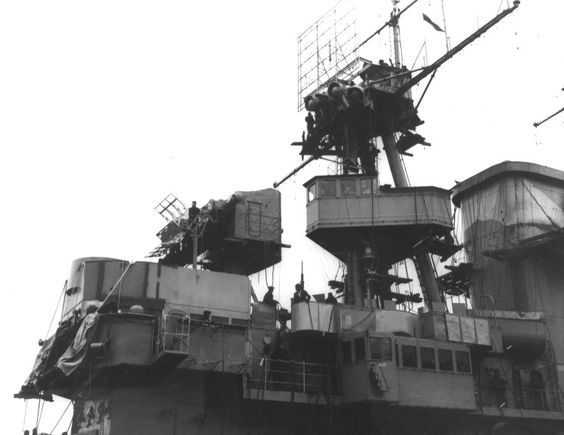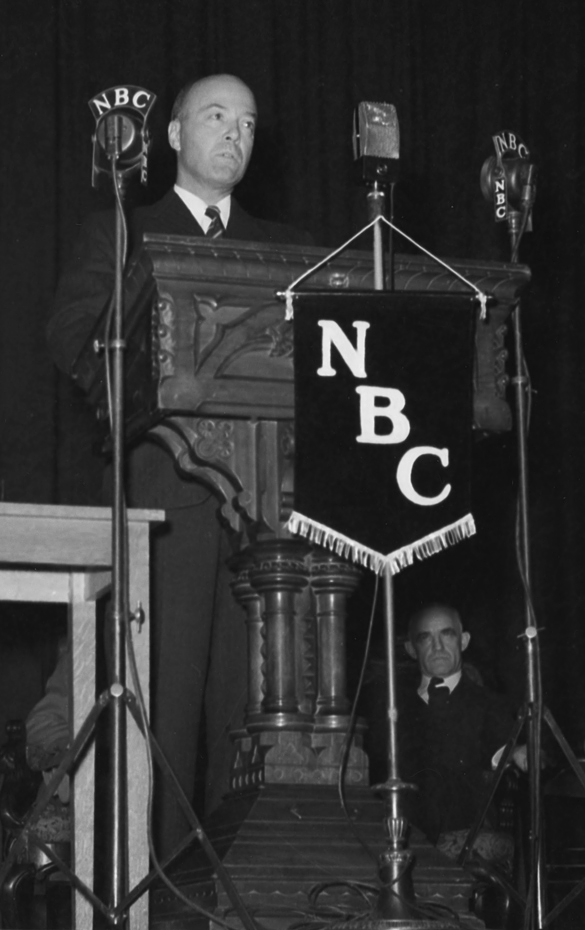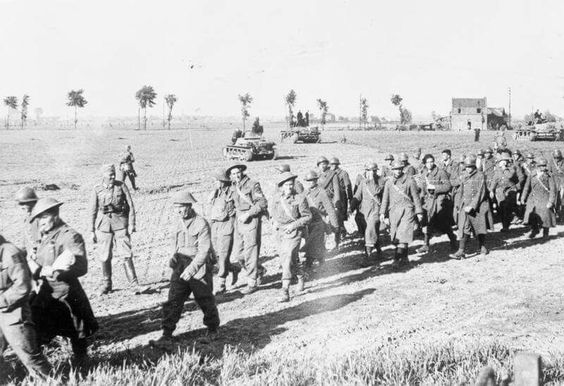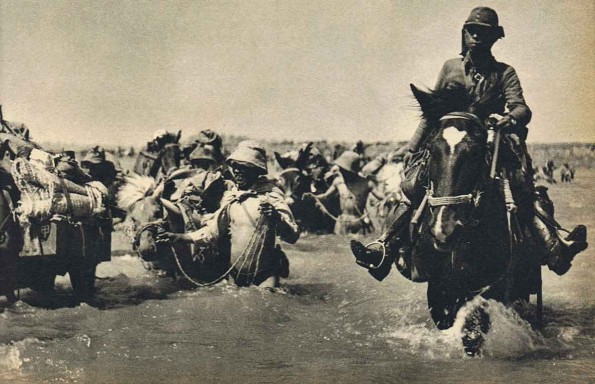Tuesday 7 January 1941
 |
| Australian light horse troops manning a Bren gun carrier, 7 January 1941 (AP). |
Italian/Greek Campaign: The Greek forces at the Klisura Pass on 7 January 1941 prepare to launch a major attack against the Italian troops defending the pass. This is the gateway to the key Italian supply port of Valona, and Greek Commander-in-chief Papagos is intent on taking the port quickly so that he can shift troops to the east to defend against an anticipated German attack by way of Bulgaria.
European Air Operations: The Luftwaffe makes a very unexpected move and launches a heavy daylight raid on London. This is the first major daylight raid in months. The bombers are over the city for almost four hours, damaging parts of fifteen different districts. Other bombers attack scattered points up and down the coast, with a lone raider targeting Coventry as well.
Battle of the Atlantic: Royal Navy corvette HMS Anemone, in cooperation with Free French corvette La Malouine, sinks Italian submarine Giacomo Nani south of Iceland.
British 975 ton coaster H.H. Petersen hits a mine and sinks in the North Sea. Everybody aboard survives.
German naval trawler UJ 175 Mob FD-31 hits a mine and sinks off Feiestein, Bru Island, Rogaland County, Norway.
Royal Navy torpedo boats MTB 32 and 34 lay minefield PW 1 in Zuydcote Pass, while German torpedo boats Kondor and Wolf lay minefield Renate off Dover. Wolf hits one of the freshly laid mines in PW 1 off Dunkirk and sinks on its way back to base.
Convoys FS 381, FS 382 and FS 383 depart from Methil, Convoy OG 49 departs from Liverpool.
Battle of the Mediterranean: Australian 6th Division, under the leadership of Major General Iven Mackay, has largely completed mopping up at Bardia. Its units now have moved on to Tobruk and captured Acroma, 10 miles to the west of the fortress. This point overlooks the coast road and puts the Australians in commanding position to interdict any Italian relief efforts (though none seem forthcoming). The British troops are outrunning their supplies and thus need to pause their operations for a spell, but Italian resistance is not one of their problems.
British Prime Minister Winston Churchill sends another cable to Middle East Commander Archibald Wavell regarding what Churchill sees as wastefulness in the Middle East army. Churchill expands upon his earlier hints that the Middle East Command is becoming a haven for slackers, deriding the low "tooth-to-tail" ratio of fighting men to supply troops.:
The enmity between Churchill and Wavell is well-known and enduring. Churchill is displaying a typical churlish reaction to victories by someone you inherently dislike: if you can't attack the results (which have been fabulous victories by Wavell), you attack the means or wastefulness by which those results were achieved (Hitler proves good at this, too).
Wavell adopts a philosophical posture in response to these peevish comments, implying that Churchill's understanding of warfare is simply out of date:
Operation Excess is proceeding. A typical 1940-41 supply convoy to Malta, it includes numerous diversions and large Royal Navy forces at heading in all sorts of different directions. Force H from Gibraltar, led by battleship HMS Malaya and aircraft carrier HMS Essex, heads out in Operation MC 4 to protect four freighters carrying troops and supplies. Other large formations, Forces A, C, and D, depart from Alexandria to cover supply ships heading from that direction (Operation MW 5 1/2). Force D includes tanker Brambleleaf, which the Royal Navy ships take to Suda Bay, Crete.
The Royal Navy also has submarines HMS Triumph, Upholder and Pandora patrolling around Sardinia. Another submarine, HMS Rover, attacks a convoy, but misses its target and instead is attacked and damaged by Italian torpedo boats Clio and Castore. Rover heads to Malta for repairs.
The British Long Range Desert Group (LRDG), having resupplied with gasoline carried by the French over the Tibesti mountains by camel, leaves its encampment near Tazerbo in western Libya. It proceeds toward its target, Murzuk, a major Italian administration center.
The Italians send destroyers and torpedo boats to lay minefields X2 and X3 north of Cape Bon.
Finnish/German Relations: Marshal Mannerheim writes Reichsmarschall Hermann Goering a letter. He requests that Germany release artillery pieces that Finland had purchased, but that had been captured aboard ships in Norwegian harbors during Operation Weserübung. This is one of an increasing number of amicable contacts between the two nations in early 1941.
US Military: Admiral Richardson, onboard flagship USS New Mexico, sends a letter to Admiral Stark that includes a copy of Admiral Bloch's letter outlining concerns about the lack of long-range patrols from Pearl Harbor. The letter's subject: "Situation Concerning the Security of the Fleet, etc." Richardson concurs with Bloch's 30 December 1940 assessment that there should be aircraft allocated to Hawaii for long-range reconnaissance patrols. This all will resurface during the Hart Inquiry Proceedings in 1942.
Japanese Military: In one of those eerie coincidences, just as the US Navy is raising concerns about security at Pearl Harbor, the Japanese Navy is beginning to plan a strike against that very target. Admiral Isoroku Yamamoto submits an assessment, Gumbi ni kansuru shiken (Views on Preparations for War). It proposes that the best strategy against the United States would be to destroy the US fleet at Pearl Harbor in the opening raid of a future war. However, at no point does he suggest invading or conquering the United States.
Yamamoto's plan is not widely approved of within the Japanese high command. The conventional Japanese strategy in any event of war with the United States has been to patiently wait for the United States to advance across the Pacific, and gradually whittle away its striking power using submarines, surface vessels, and airplanes. This is virtually a mirror image of the US strategy proposed by the US Navy, which envisages a purely defensive war in the Pacific while the main effort focuses on Europe. The Yamamoto plan envisages scoring a dramatic victory in the war's opening hours and then trying to secure a peace deal to consolidate gains in Japan's real areas of interest: the Dutch East Indies, British bases in Hong Kong and Singapore, and the Philippines, among others.
There is a potential problem with Yamamoto's plan: it relies upon US willingness to make a deal quickly. However, this may not be possible in the event of a surprise attack that arouses US war passions. Thus, a formal declaration of war and then an attack is the preferred way to go in order to leave open this avenue of resolution.
US Government: With Executive Order 8629, President Franklin Roosevelt establishes the Office of Production Management (OPM) and the Office for Emergency Management. Their purposes: to "increase, accelerate and regulate" items necessary for the national defense, and to "advise and assist the President" regarding "any emergency arising out of war," respectively. The OPM, in particular, is just the start of much more extensive bureaucracies created to manage war production, with the overall federal bureaucracy nearly quadrupling. Industrialist William S. Knudsen, labor leader Sidney Hillman, U.S. Secretary of the Navy William "Frank" Knox, and U.S. Secretary of War Henry L. Stimson lead the Council.
British Government: Churchill and his War Cabinet discuss his assessment that Middle East forces need to be transferred to Greece to support that country against a threatened Wehrmacht invasion. He tells General Hastings Ismay, his de facto military adjutant, that the “speedy destruction of the Italian Armed Forces in North East Africa must be our prime overseas objective in the opening months of 1941.”
Canadian Government: The War Cabinet Committee receives a split-decision recommendation from a subcommittee that Japanese-Canadians be barred from military service due to public hostility to them.
China: Nationalist Chinese (Kuomintang) units attack and surround units of the New Fourth Army in Maolin, Anhui Province.
American Homefront: Former ambassador William C. Bullitt has submitted his resignation as ambassador to France - he already has been replaced by Admiral William D. Leahy, who today already is in Vichy - and President Roosevelt today accepts it "with great reluctance." By coincidence (perhaps), Bullitt also gives a stirring speech at the University of North Carolina, Chapel Hill today. He states in pertinent part:
"Inner Sanctum Mysteries" aka The Inner Sanctum, created by producer Himan Brown and based on the imprint of Simon & Schuster mystery novels, premieres on the NBC Blue Network. Host Raymond Edward Johnson (who goes by his first name on the show) maintains a sardonic tone that borders on high camp. The mysteries themselves are straightforward tales that could have been taken from the works of Edgar Allan Poe or Sir Arthur Conan Doyle. The show is a huge radio hit and the forerunner of television shows such as "Alfred Hitchcock Presents" and "The Outer Limits."
January 2, 1941: Camp Categories
January 3, 1941: Liberty Ships
January 4, 1941: Aussies Take Bardia
January 5, 1941: Amy Johnson Perishes
January 6, 1941: Four Freedoms
January 7, 1941: Pearl Harbor Plans
January 8, 1941: Billions For Defense
January 9, 1941: Lancasters
January 10, 1941: Malta Convoy Devastation
January 11, 1941: Murzuk Raid
January 12, 1941: Operation Rhubarb
January 13, 1941: Plymouth Blitzed
January 14, 1941: V for Victory
January 15, 1941: Haile Selassie Returns
January 16, 1941: Illustrious Blitz
January 17, 1941: Koh Chang Battle
January 18, 1941: Luftwaffe Pounds Malta
January 19, 1941: East African Campaign Begins
January 20, 1941: Roosevelt 3rd Term
January 21, 1941: Attack on Tobruk
January 22, 1941: Tobruk Falls
January 23, 1941: Pogrom in Bucharest
January 24, 1941: Tank Battle in Libya
January 25, 1941: Panjiayu Tragedy
January 26, 1941: Churchill Working Hard
January 27, 1941: Grew's Warning
January 28, 1941: Ho Chi Minh Returns
January 29, 1941: US Military Parley With Great Britain
January 30, 1941: Derna Taken
January 31, 1941: LRDG Battered
2020
European Air Operations: The Luftwaffe makes a very unexpected move and launches a heavy daylight raid on London. This is the first major daylight raid in months. The bombers are over the city for almost four hours, damaging parts of fifteen different districts. Other bombers attack scattered points up and down the coast, with a lone raider targeting Coventry as well.
Battle of the Atlantic: Royal Navy corvette HMS Anemone, in cooperation with Free French corvette La Malouine, sinks Italian submarine Giacomo Nani south of Iceland.
British 975 ton coaster H.H. Petersen hits a mine and sinks in the North Sea. Everybody aboard survives.
German naval trawler UJ 175 Mob FD-31 hits a mine and sinks off Feiestein, Bru Island, Rogaland County, Norway.
Royal Navy torpedo boats MTB 32 and 34 lay minefield PW 1 in Zuydcote Pass, while German torpedo boats Kondor and Wolf lay minefield Renate off Dover. Wolf hits one of the freshly laid mines in PW 1 off Dunkirk and sinks on its way back to base.
Convoys FS 381, FS 382 and FS 383 depart from Methil, Convoy OG 49 departs from Liverpool.
 |
| HMS Largs, 7 January 1941. This was the French armed merchant cruiser (AMC) Charles Plumer, captured by destroyer HMS Faulknor on 22 November 1940 off Gibraltar. It has been converted into an ocean boarding vessel. © IWM (A 6944) |
British Prime Minister Winston Churchill sends another cable to Middle East Commander Archibald Wavell regarding what Churchill sees as wastefulness in the Middle East army. Churchill expands upon his earlier hints that the Middle East Command is becoming a haven for slackers, deriding the low "tooth-to-tail" ratio of fighting men to supply troops.:
You have well over 350,000 troops on your ration strength and the number of units which are fighting or capable of fighting appears to me disproportionately small.In other words, Churchill is implying that the majority of soldiers under Wavell's command are unproductive shirkers. Churchill also comments:
Rations of heavy munitions workers are being cut down to levels of which British armies except in actual operations have never dreamed. Severe stringency in human rations and the slaughter of cattle through lack of feedstuffs lie before us. The voyage round the Cape imposes an almost prohibitive burden.This, too, is cutting, implying that the soldiers under Wavell's command are living "high on the hog" whilst the workers back home are starving.
The enmity between Churchill and Wavell is well-known and enduring. Churchill is displaying a typical churlish reaction to victories by someone you inherently dislike: if you can't attack the results (which have been fabulous victories by Wavell), you attack the means or wastefulness by which those results were achieved (Hitler proves good at this, too).
Wavell adopts a philosophical posture in response to these peevish comments, implying that Churchill's understanding of warfare is simply out of date:
Winston's tactical ideas had to some extent crystallised in the South African war [of 1898-1900].This is another instance of catty infighting within the British high command, exemplified by the recent ousting of Air Marshal Dowding and Air Vice-Marshal Keith Park, victors of the Battle of Britain, from their commands in late 1940.
Operation Excess is proceeding. A typical 1940-41 supply convoy to Malta, it includes numerous diversions and large Royal Navy forces at heading in all sorts of different directions. Force H from Gibraltar, led by battleship HMS Malaya and aircraft carrier HMS Essex, heads out in Operation MC 4 to protect four freighters carrying troops and supplies. Other large formations, Forces A, C, and D, depart from Alexandria to cover supply ships heading from that direction (Operation MW 5 1/2). Force D includes tanker Brambleleaf, which the Royal Navy ships take to Suda Bay, Crete.
The Royal Navy also has submarines HMS Triumph, Upholder and Pandora patrolling around Sardinia. Another submarine, HMS Rover, attacks a convoy, but misses its target and instead is attacked and damaged by Italian torpedo boats Clio and Castore. Rover heads to Malta for repairs.
The British Long Range Desert Group (LRDG), having resupplied with gasoline carried by the French over the Tibesti mountains by camel, leaves its encampment near Tazerbo in western Libya. It proceeds toward its target, Murzuk, a major Italian administration center.
The Italians send destroyers and torpedo boats to lay minefields X2 and X3 north of Cape Bon.
 |
| A view of USS Wasp's (CV-7) radar arrays whilst in the Norfolk Naval Shipyard refitting on 7 January 1941. The Wasp has been re-deployed to the Atlantic. |
US Military: Admiral Richardson, onboard flagship USS New Mexico, sends a letter to Admiral Stark that includes a copy of Admiral Bloch's letter outlining concerns about the lack of long-range patrols from Pearl Harbor. The letter's subject: "Situation Concerning the Security of the Fleet, etc." Richardson concurs with Bloch's 30 December 1940 assessment that there should be aircraft allocated to Hawaii for long-range reconnaissance patrols. This all will resurface during the Hart Inquiry Proceedings in 1942.
 |
| USS Wasp at the Norfolk Naval Shipyard, 7 January 1941. |
Yamamoto's plan is not widely approved of within the Japanese high command. The conventional Japanese strategy in any event of war with the United States has been to patiently wait for the United States to advance across the Pacific, and gradually whittle away its striking power using submarines, surface vessels, and airplanes. This is virtually a mirror image of the US strategy proposed by the US Navy, which envisages a purely defensive war in the Pacific while the main effort focuses on Europe. The Yamamoto plan envisages scoring a dramatic victory in the war's opening hours and then trying to secure a peace deal to consolidate gains in Japan's real areas of interest: the Dutch East Indies, British bases in Hong Kong and Singapore, and the Philippines, among others.
There is a potential problem with Yamamoto's plan: it relies upon US willingness to make a deal quickly. However, this may not be possible in the event of a surprise attack that arouses US war passions. Thus, a formal declaration of war and then an attack is the preferred way to go in order to leave open this avenue of resolution.
US Government: With Executive Order 8629, President Franklin Roosevelt establishes the Office of Production Management (OPM) and the Office for Emergency Management. Their purposes: to "increase, accelerate and regulate" items necessary for the national defense, and to "advise and assist the President" regarding "any emergency arising out of war," respectively. The OPM, in particular, is just the start of much more extensive bureaucracies created to manage war production, with the overall federal bureaucracy nearly quadrupling. Industrialist William S. Knudsen, labor leader Sidney Hillman, U.S. Secretary of the Navy William "Frank" Knox, and U.S. Secretary of War Henry L. Stimson lead the Council.
 |
| William C. Bullitt, speaking at UNC-Chapel Hill on 7 January 1941. |
Canadian Government: The War Cabinet Committee receives a split-decision recommendation from a subcommittee that Japanese-Canadians be barred from military service due to public hostility to them.
China: Nationalist Chinese (Kuomintang) units attack and surround units of the New Fourth Army in Maolin, Anhui Province.
American Homefront: Former ambassador William C. Bullitt has submitted his resignation as ambassador to France - he already has been replaced by Admiral William D. Leahy, who today already is in Vichy - and President Roosevelt today accepts it "with great reluctance." By coincidence (perhaps), Bullitt also gives a stirring speech at the University of North Carolina, Chapel Hill today. He states in pertinent part:
At this time of danger, each American must ask himself each day not what he can get from his country but what he can give to his country, and must ask himself each night: “Have I given enough?”Anyone with an ear for history will recognize that this quotation is quite similar to another quote from a certain 1961 JFK inauguration speech.
"Inner Sanctum Mysteries" aka The Inner Sanctum, created by producer Himan Brown and based on the imprint of Simon & Schuster mystery novels, premieres on the NBC Blue Network. Host Raymond Edward Johnson (who goes by his first name on the show) maintains a sardonic tone that borders on high camp. The mysteries themselves are straightforward tales that could have been taken from the works of Edgar Allan Poe or Sir Arthur Conan Doyle. The show is a huge radio hit and the forerunner of television shows such as "Alfred Hitchcock Presents" and "The Outer Limits."
January 1941
January 1, 1941: Muselier ArrestedJanuary 2, 1941: Camp Categories
January 3, 1941: Liberty Ships
January 4, 1941: Aussies Take Bardia
January 5, 1941: Amy Johnson Perishes
January 6, 1941: Four Freedoms
January 7, 1941: Pearl Harbor Plans
January 8, 1941: Billions For Defense
January 9, 1941: Lancasters
January 10, 1941: Malta Convoy Devastation
January 11, 1941: Murzuk Raid
January 12, 1941: Operation Rhubarb
January 13, 1941: Plymouth Blitzed
January 14, 1941: V for Victory
January 15, 1941: Haile Selassie Returns
January 16, 1941: Illustrious Blitz
January 17, 1941: Koh Chang Battle
January 18, 1941: Luftwaffe Pounds Malta
January 19, 1941: East African Campaign Begins
January 20, 1941: Roosevelt 3rd Term
January 21, 1941: Attack on Tobruk
January 22, 1941: Tobruk Falls
January 23, 1941: Pogrom in Bucharest
January 24, 1941: Tank Battle in Libya
January 25, 1941: Panjiayu Tragedy
January 26, 1941: Churchill Working Hard
January 27, 1941: Grew's Warning
January 28, 1941: Ho Chi Minh Returns
January 29, 1941: US Military Parley With Great Britain
January 30, 1941: Derna Taken
January 31, 1941: LRDG Battered
2020
















